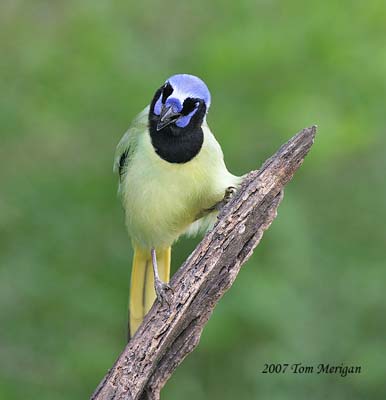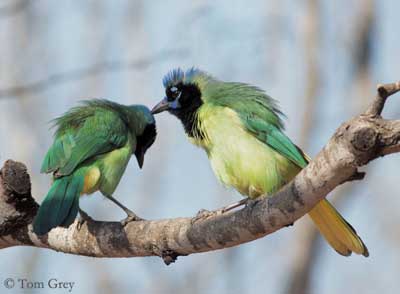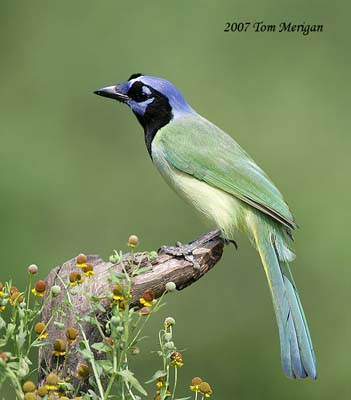
Green Jay
Cyanocorax yncas
Passeriforme Order – Corvidae Family
BIOMETRICS:
Length: 25-27 cm
Weight: 66-92 gr
DESCRIPTION:
Green Jay is the unique green species among numerous purple, blue, buff, grey and black jays. It is a New World species.
PROTECTION / THREATS / STATUS:
Green Jay is usually common, often local. This species is not threatened at this moment.
Fr: Geai vert
All : Grünhäher
Esp : Urraca Querrequerre
Ital: Ghiandaia verde
Russe: Зелёная сойка
Sd: Grönskrika
Photographs by Tom Merigan
Tom Meriganís Photo Galleries
Photograph of the pair by Tom Grey
Tom Grey's Bird Pictures
Text by Nicole Bouglouan
Sources:
HANDBOOK OF THE BIRDS OF THE WORLD Vol 14 by Josep del Hoyo-Andrew Elliot-David Christie - Lynx Edicions –
ISBN: 9788496553507
CROWS AND JAYS by Steve Madge – Ed. Christopher Helm – ISBN: 0713652071
A GUIDE TO THE BIRDS OF MEXICO AND NORTHERN CENTRAL AMERICA by Steve N. G. Howell, Sophie Webb - Oxford University Press - ISBN: 0198540124
A GUIDE TO THE BIRDS OF COLOMBIA by Steven L. Hilty and William L. Brown - Princeton University Press – ISBN 069108372X
SORA Searchable Ornithological Research Archive (Blair O. Wolf)
Wikipedia (Wikipedia, The Free Encyclopedia)

Adult has soft green upperparts and upperwings. In some birds, the rump may be yellow. The tail is darker green with yellow outer rectrices.
The underparts are pale yellow-green from the lower breast to the undertail coverts. Undertail feathers are yellow with dark tips. Underwings are brownish with yellow base.
On the head, crown and nape are ultramarine, paler on the lower nape. The forehead, a small rounded spot above the eye and a large malar patch ending behind the eye show the same blue.
We can see a short, bushy crest at base of upper mandible, formed by the stiff erect nasal and frontal feathers. A white patch separates the eyes on the forehead.
The rest of the head, chin, throat and bib extending to the head sides and behind the eye are black. Another black patch includes the lores and the anterior part of the eye, and joins the rear eye, as a mask.
The bill is black. Eyes are dark brown to yellow according to the race. Legs and feet are greyish.
Both sexes are similar.
Juvenile has shorter frontal feathers, and the spot above the eye is absent.
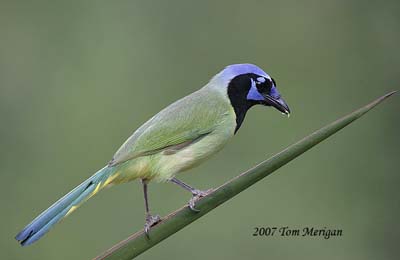
We can find several races which differ in colour, size and head pattern.
The race displayed and described is Cyanocorax yncas glaucescens, from extreme south USA (S Texas) and NE Mexico.
VOICE: SOUNDS BY XENO-CANTO
Green Jay has wide repertoire including varied calls such as a shrill chatter “cha,cha,cha…”, a loud, ringing “chenk chenk chenk”, a drier scolding “cheh-cheh…”, a buzzer, nasal “jehrjihjihjih…”, and a throaty croaking “ahrrrrrr”.
It is a noisy bird giving discordant calls, vocal mimicry, mewing, chattering, clicking, rattling and rasping notes.
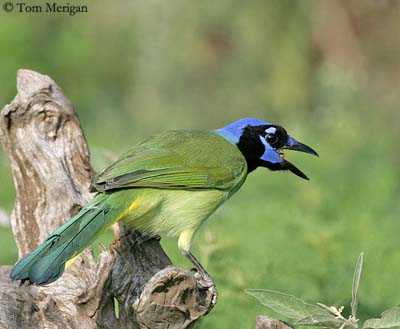
HABITAT:
Green Jay frequents varied habitats such as tropical deciduous forest and humid edges, thickets along streams, grasslands with scattered trees, dry scrub areas and matorral. It may be seen sometimes in marshlands.
According to the range, the races occupy different habitats and elevations.
RANGE:
Green Jay is found from southern Texas, south into Mexico and Central America (absent from Nicaragua and Panama), and then, in South America in Colombia, Venezuela, Ecuador, Peru and Bolivia.
This range involved two separated groups, the N American races being named Green Jay and the S American birds are named Inca Jay.
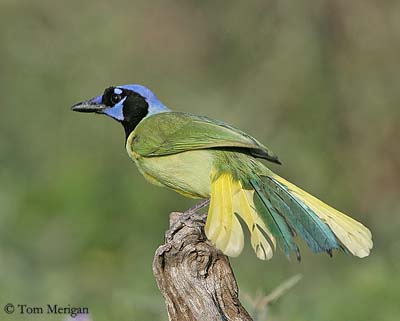
BEHAVIOUR:
Green Jay feeds on insects and other invertebrates, and seeds, fruits and berries, acorns, small birds and eggs of other species.
Some observations tell us that Green Jay may use tools such as small twig held in the bill, in order to reach insects into bark crevices.
They usually forage in small groups, often in subcanopy and in the shrubby understorey. It searches for food on the ground, on tree trunks, branches and lichens.
The bird hops along the branches. It stretches upwards its body to reach the food items above, or hangs down to take the items below. Usually, the Green Jay carries the food in the bill to a perch, it holds it in the feet and pecks it apart, making small bits.
On the ground, it turns over the leaf litter with lateral movements of the bill. This species avoids the clearings and the open areas.
It may pursue insects in flight, and hover to pluck fruits and insects from the vegetation.

Green Jay is usually solitary nester in the northern parts of the range, whereas further south, the birds form territorial groups all year round. The group includes 3-9 birds, one breeding pair and immature helpers.
If a predator approaches the nest-site, the flock surrounds the intruder while calling, and attempts to force it to leave the area. They can be very aggressive in defence.
The northern populations gather in large flocks after the breeding season.
During the courtship displays, one bird moves around the other while displaying. Usually, the male expose the bright colours of the plumage and erects the crest or twists the tail.
Green jay is sedentary within its range.
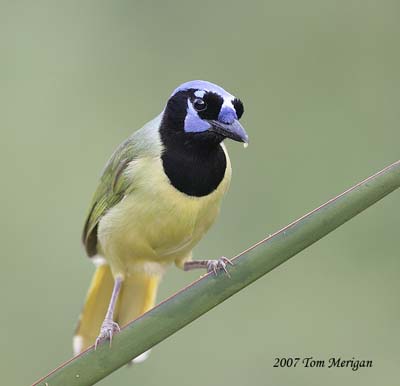
FLIGHT:
Green Jay flies rarely over open areas and clearings, but when doing so, it performs laboured and flapping flight.
However, it may be very agile when hovering for food or pursuing insects.
REPRODUCTION:
Breeding season occurs in April-June in USA and March-August in Colombia.
Green Jay has two breeding systems, the northern birds being solitary nesters, and the southern birds performing co-operative breeding with one pair and some helpers.
The nest is situated in a fork close to the tree trunk, or in a bush, usually between 1, 50 and 10 metres above the ground. It is a shallow basket made with loosely woven twigs. The interior is lined with fine roots, stems, dried grass, lichens and leaves.
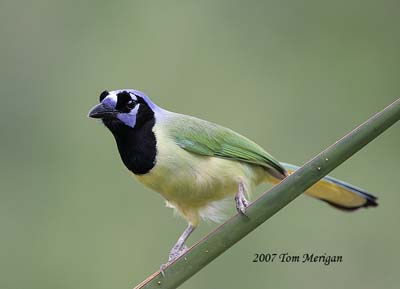
Female lays 3-5 eggs. Incubation lasts about 17-18 days. Young leave the nest 19 to 22 days later. They are fed for three weeks or more after fledging by both parents, or in co-operative systems, by helpers.
The northern races are sometimes parasitized by Bronzed Cowbird.
DIET:
Green Jay is omnivorous and feeds on insects such as beetles, bugs, grasshoppers, crickets, caterpillars, and also lizard’s eggs, earthworms and plant matter such as seeds, fruits and berries.
